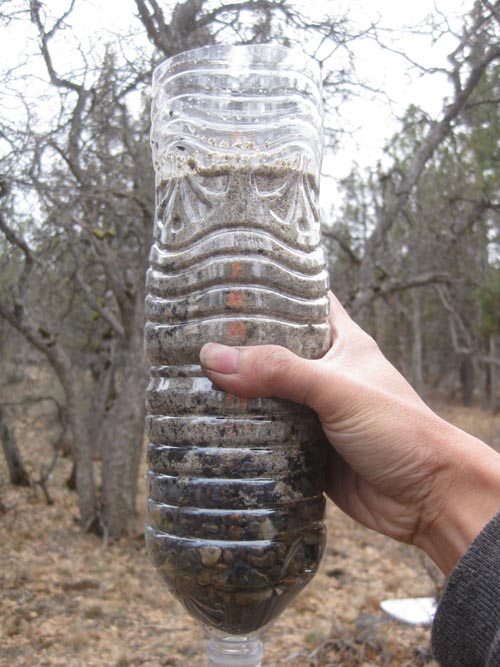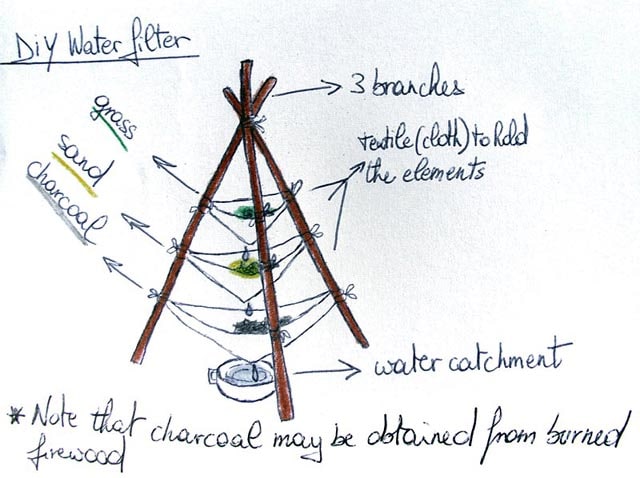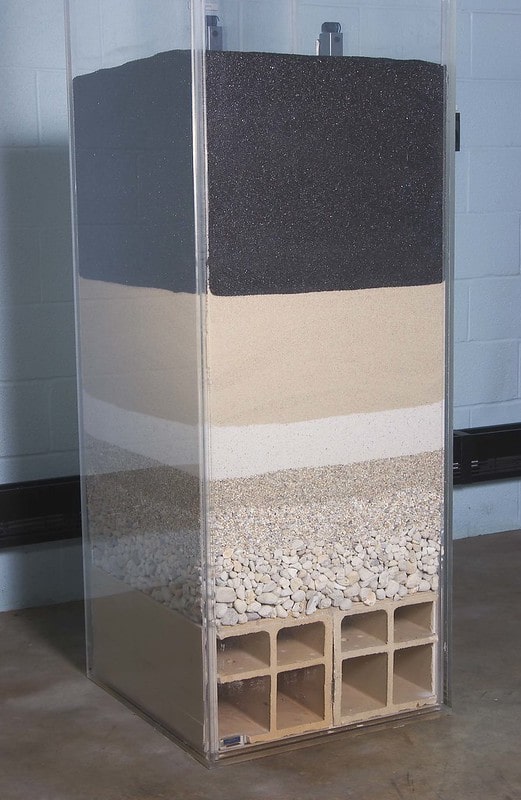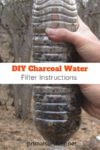Charcoal is an amazing substance with many survival uses, one of which is for water filters. It’s what’s used in Brita filters, many camping filters, and even high-end water filters like The Berkey.
The charcoal absorbs impurities in water and is actually one of the only ways of removing chemicals from water, such as pesticides and runoff.
These instructions for a DIY charcoal water filter are very easy. Yet, it is essentially the same process used in city water treatment facilities (just on a smaller scale).
How to Make a Charcoal Water Filter Instructions
1. Get activated charcoal
You cannot use barbecue charcoal to make a water filter, the reason being that most charcoal you buy at stores is not pure and could leach numerous chemical contaminants into the water (which defeats the point of making a charcoal water filter). Instead, you will want to make activated charcoal.
In a wilderness survival situation, you could make your own basic activated charcoal out of hardwood.
After making activated charcoal, you will need to crush it into a powder.
Alternatively, you can buy activated charcoal. It is available in bulk on Amazon at a decent price.
Read:
2. Rinse your activated charcoal
Before using activated charcoal for filtering water, you should rinse it to remove any impurities on the surface. Then spread it on paper and let it dry. This is the same reason you need to soak a Brita filter before using it and the step is even recommended by NASA (1).
3. Create your filter vessel
Most survival charcoal water filters are made from 2-liter plastic bottles.
If you don’t have a bottle handy, you can use cloth to hold each filter layer (see pictures in section below). Or, if you are very skilled at bushcraft, you can make a cone out of birch bark.
Notes:
- It takes a while for dirty water to pass through a charcoal filter. If there are many people in your group or a long-term survival situation is in question, you’ll want to use buckets for your DIY filter.
- A funnel shape is ideal for charcoal filters, especially if you have a limited amount of activated charcoal available.
4. Gather pre-filter materials
It is possible to make the filter out of just charcoal. However, any debris, algae, or other scum in the water can clog the top layer of charcoal. For this reason, it’s recommended that you make a layered filter.
Usually gravel and sand are used as pre-filter media. However, I’ve heard of people using things like cotton balls, pieces of concrete, and even uncooked macaroni.
5. Layer filter media
Going from bottom to top, the DIY water filter layers go:
- Tight-knit cloth or coffee filter: This layer stops any charcoal pieces from getting into the water collection vessel.
- Activated charcoal: This is the layer which will absorb chemical impurities from the water.
- Sand: It’s also possible to used smashed-up pieces of brick for this.
- Small pebbles: These will filter out larger pieces of debris which the previous layer missed.
- Larger pebbles and/or grass: This layer catches large pieces of debris in the water.
Notes that some people put these layers in different orders, such as starting with sand and then using pebbles. Or some people will repeat these layers.
6. Pour water into the filter
Pour water into the top layer of the filter. This is technically a “gravity filter” as you have to wait for the water to work its way through each of the layers. Yes, it will take a while!
7. Kill pathogens
Activated charcoal will absorb impurities in the water, including viruses, bacteria, and parasites. However, it will not absorb all of them. It doesn’t take much of these pathogens to cause gut-wrenching diarrhea and vomiting! Diarrhea and puking WILL dehydrate you, which can be life threatening.
For this reason, you absolutely must further treat water from charcoal filter. Some options include:
- Boiling
- Water purification tablets
- Household bleach: Read how to purify water with bleach
- Camping/survival water filter: It won’t remove viruses but those usually aren’t an issue in backcountry water
- 0.01 micron water filter: Water filters with pores this size are effective at removing viruses as well as bacteria and protozoa.
Read:
Examples of DIY Charcoal Filters



“water filter” (CC BY 2.0) by ryochiji



lugols iodine couple of drops per litre
a Canadian maple coin or any 99.999 piece of silver placed in the filtered water for a few hours you could even toss it into the boiling water
a small bottle of colodial Silver a few drops per litre
an old piece of white linen an old t shirt a piece of silk as the first stage
can all be added into the mix.
make your own colloidal silver low voltage
make your own chlorine dioxide as per Andreas Kalcker
very powerful gas infused liquid a couple of droplets in filtered water
Diane, What about DE filter material? Or is it too fine without the usual mesh insert that it’s loaded onto? Thanks.
I want to make a rainwater filter in a 30/50 gal drum. In what sequence do you make layers? water enters Sand first, carbon last? Or water enter large gravel, small gravel, sand and charcoal last. Is burlap a good material for between layers? I assume the garden weed block material is not good. Would also think sand on top would be easier to clean and/or replace.
From top to bottom, it goes: large stones/gravel, smaller stones, sand, activated charcoal.
But you really shouldn’t use activated charcoal on a rainwater filter. You only need a mesh or gravel filter to keep leaves and large debris out. The water is going to be sitting around in the barrel for a while anyway, so the charcoal filter won’t achieve much in terms of benefits. Also, that sort of filter will slow down the flow greatly — so you risk the rainwater overflowing before it gets into the drum. You can use charcoal to treat the rainwater AFTER it has collected and you are ready to use it. Though, depending on what you are using the rainwater for, you might not even need to do that.
If you are preparing beforehand, there two kinds of sand. Under a microscope you can see that one kind is round like River pebbles, the other kind has sharp points like broken rocks. Ideally you will get the kind with the Sharp points. That’s the kind of sand that you use for a filter for a swimming pool. You can get it at a pool shop, it’s not as cheap as play sand which is round. The sharp points are more effective because even microscopically they will snag and catch more impurities than the round sand. So if you have the opportunity, buy the pool filter sand to have on hand. You can backwash it to keep it clean after it’s been used.
Thanks for the clarity with this.
Can you just use charcoal from your fire? Ground down and with the ash rinsed off?
And if the water is then boiled afterwards would that constitute a reliable clean water?
Is it better to use activated charcoal powder or small granules, like gravel?
Smaller/finer is always better with activated charcoal. This is because smaller grains (even if using the exact same amount by weight) will have more surface area, and thus be able to adsorb more impurities. The same applies for using activated charcoal as medicine, such as for treating food poisoning or making a poltice.
How much water can you filter before you need to use fresh filer materials? Probably depends on the dirtiness or cleanness of the water that’s been filtered. But I have no idea at all about when the filter material would be too saturated with pollutants to be usable.
That’s a big problem with charcoal water filters: you really have no way of knowing when the charcoal has received its capacity. The dirtier the water, the faster it gets filled up. For a lot of store-bought charcoal filters for camping, the filter life is only around 50-300 gallons. The smaller the size, the shorter the lifespan.
I would think that, if the turbidity of the water was fairly constant, that a greatly reduced flow would be the first indicator. Regardless, I’m looking at this and, adapting an affordable (Amazon), 5-stage under sink system, followed by a .01-micron Life-Straw filter at the output end. Flow will be by either gravity or a 12-volt, diaphragm, water pump that has an adjustable pressure regulator capable of delivering several GPM. As long as some POS doesn’t destroy it, I plan on using pool water, so that type of system should suffice. Hope I never have to use it.
good article,, consistent with what I learned.
I’d add in an advisory for folks to practice with this tool.
Good work.
Thanks,
Agreed, Thank you to All those whom have contributed to the establishment of the site and the information, humbled regards, Sean.
Let’s say I have a cup of lake water and all particles has been filtered out. Can you literally just drop activated carbon to strip away chemical pollutants. Or does it need to pass through the activated carbon.
Adding activated carbon to the water will allow the chemicals to adhere to the carbon, but you still need to filter out the carbon (and the chemicals now stuck to it). So, it is easier/more effective to create a filter ‘cartridge’ containing the activated carbon, and allow the water to pass through it.
I will add that pre-filtering to remove all large/visible particles is a great idea. This can be done easily by using any fabric on hand (i.e. an old T-shirt). This will increase the longevity of your carbon filter.
Thanks for the article. I read it and re read it many times. Just to memorize the steps. Cause when SHTF. I’m going to be ready and Smart.